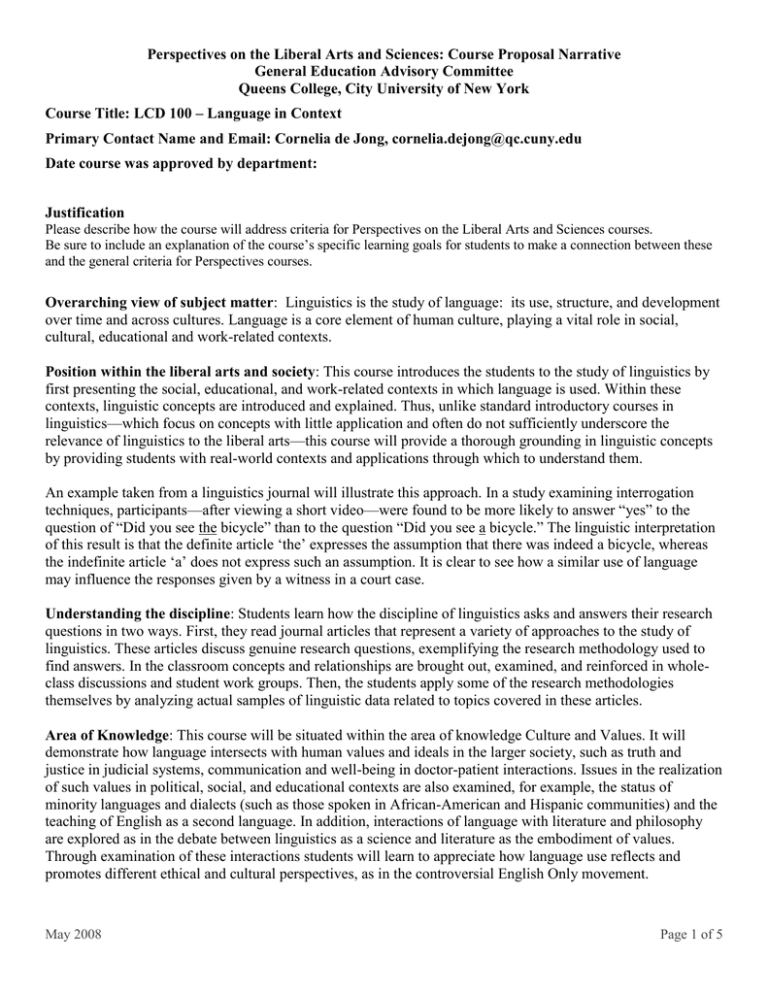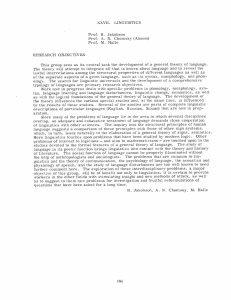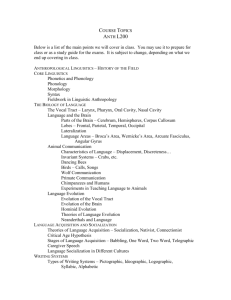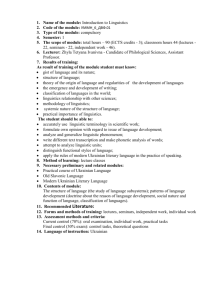Perspectives on the Liberal Arts and Sciences: Course Proposal Narrative
advertisement

Perspectives on the Liberal Arts and Sciences: Course Proposal Narrative General Education Advisory Committee Queens College, City University of New York Course Title: LCD 100 – Language in Context Primary Contact Name and Email: Cornelia de Jong, cornelia.dejong@qc.cuny.edu Date course was approved by department: Justification Please describe how the course will address criteria for Perspectives on the Liberal Arts and Sciences courses. Be sure to include an explanation of the course’s specific learning goals for students to make a connection between these and the general criteria for Perspectives courses. Overarching view of subject matter: Linguistics is the study of language: its use, structure, and development over time and across cultures. Language is a core element of human culture, playing a vital role in social, cultural, educational and work-related contexts. Position within the liberal arts and society: This course introduces the students to the study of linguistics by first presenting the social, educational, and work-related contexts in which language is used. Within these contexts, linguistic concepts are introduced and explained. Thus, unlike standard introductory courses in linguistics—which focus on concepts with little application and often do not sufficiently underscore the relevance of linguistics to the liberal arts—this course will provide a thorough grounding in linguistic concepts by providing students with real-world contexts and applications through which to understand them. An example taken from a linguistics journal will illustrate this approach. In a study examining interrogation techniques, participants—after viewing a short video—were found to be more likely to answer “yes” to the question of “Did you see the bicycle” than to the question “Did you see a bicycle.” The linguistic interpretation of this result is that the definite article ‘the’ expresses the assumption that there was indeed a bicycle, whereas the indefinite article ‘a’ does not express such an assumption. It is clear to see how a similar use of language may influence the responses given by a witness in a court case. Understanding the discipline: Students learn how the discipline of linguistics asks and answers their research questions in two ways. First, they read journal articles that represent a variety of approaches to the study of linguistics. These articles discuss genuine research questions, exemplifying the research methodology used to find answers. In the classroom concepts and relationships are brought out, examined, and reinforced in wholeclass discussions and student work groups. Then, the students apply some of the research methodologies themselves by analyzing actual samples of linguistic data related to topics covered in these articles. Area of Knowledge: This course will be situated within the area of knowledge Culture and Values. It will demonstrate how language intersects with human values and ideals in the larger society, such as truth and justice in judicial systems, communication and well-being in doctor-patient interactions. Issues in the realization of such values in political, social, and educational contexts are also examined, for example, the status of minority languages and dialects (such as those spoken in African-American and Hispanic communities) and the teaching of English as a second language. In addition, interactions of language with literature and philosophy are explored as in the debate between linguistics as a science and literature as the embodiment of values. Through examination of these interactions students will learn to appreciate how language use reflects and promotes different ethical and cultural perspectives, as in the controversial English Only movement. May 2008 Page 1 of 5 The proposed course meets other Perspective criteria as well. The course is global in nature, but not only because it covers a range of sub-disciplines, like phonology, syntax, and pragmatics. More importantly, the course also addresses a wide range applications to society, such as law, social policy, translation, and instruction, which naturally bring up the issues of diversity (gender and race; bilingualism) and change over time (historical linguistics). All texts read for this course are primary documents, mostly journal articles, but also documents like Nunberg’s Testimony before the California legislature, regarding the decision over whether or not to make English the official State language. Primary materials are also used to reinforce the concepts that are introduced in the course, when students complete assignments like gathering and analyzing authentic data. Such assignments would involve obtaining and analyzing machine-translated texts from Google Translate or Yahoo Babel Fish (online translators). Criteria Checklist Please be sure that your justification addresses all three criteria 1-3, below. For criteria 4-8, please check all that apply and discuss these in your justification. A Perspectives course must: 1. Be designed to introduce students to how a particular discipline creates knowledge and understanding. 2. Position the discipline(s) within the liberal arts and the larger society. 3. Address the goals defined for the particular Area(s) of Knowledge the course is designed to fulfill. In addition, a Perspectives course will, where appropriate to its discipline(s) and subject matter: 4. Be global or comparative in approach. 5. Consider diversity and the nature and construction of forms of difference. 6. Engage students in active inquiry. 7. Reveal the existence and importance of change over time. 8. Use primary documents and materials. Course Materials, Assignments, and Activities Please provide an annotated list of course readings and descriptions of major assignments or exams for the course, as well as distinctive student activities that will engage students in working toward the course goals discussed in the course description and/or justification. Please include the author and title for each reading or text, along with a short description providing information about how the reading will contribute to course goals. Readings: The course readings will consist of select linguistics journal articles published in Oaks, Dallin D. (1999). Linguistics at work: A reader of applications. New York: Harcourt Brace College Publishers. Overarching and unit-specific goals: This course introduces the students to the study of linguistics by first presenting the social, educational, and work-related contexts in which language is used. Within these contexts, linguistic concepts are introduced and explained. Specific language- and context-related goals pertaining to each reading are indicated in reading list (please see below) in parentheses. Assignments: These will include graded activities (in-class and homework; see reading list below) through which students will become familiar with both the linguistic and context-related issues raised by each reading. Exams: There will be a midterm exam and a final exam on the course material. Some exam test-tasks will include fact-related or definitional issues, but most will comprise tasks requiring integration and application of linguistic concepts and principles learned. May 2008 Page 2 of 5 Student activities: (See reading list, below) Reading list (author and title), organized by specific work-related context (with suggested accompanying activities/assignments) Unit 1: Linguistics in medicine and therapy Fisher, S. Doctor Talk/Patient Talk (Goal: Understanding semantics and pragmatics, in the context of medicine and therapy) ACTIVITY: In-class discussion comparing this paper to a more up-to-date paper TBD. ACTIVITY: Small groups come up with potential research questions concerning doctor-patient interactions. Diaz-Duque, O. F. Communication barriers in medical settings (Goal: Understanding language varieties and register, in the context of medicine and therapy.) ACTIVITY: Do (and record) a role-play (in English) of a doctor’s visit. Translate the text into another language. Do you find any difficulties? Are they similar to those described in the chapter? Specify disease, culture (hispanic, middle eastern; if possible), etc. ‘POST-TEACHING’: Discuss more up-to-date research on this topic. Unit 2: Linguistics and the law Loftus, E.F. Language and memories in the judicial system (Goal: Understanding psycholinguistics, language acquisition, morphology, semantics, pragmatics, in the context of the law) ACTIVITY: Interactive handout with pairs of structures, as in text. ACTIVITY: Analyze excerpts of political speeches or TV advertisements. Labov, W. The judicial testing of linguistic theory (Focus: Phonetics and phonology, in the context of the law) PRE-TEACHING: Pre-teach vowel features and relevant IPA symbols, also vowel triangles with PowerPoint handouts on Blackboard. ACTIVITY: Listen to speech archive samples; transcribe friends’ pronunciation of vowels from word list we give them Unit 3: Linguistics in business and the workplace Cohen, B. There’s more to a name (Goal: Understanding phonetics and phonology, in the context of business and the workplace) PRE-TEACHING: Teach consonantal features and relevant IPA symbols ACTIVITY: Evaluate brand names of actual products. Use linguistic terminology to explain the names. (Transcribe vowels as well as consonants) ACTIVITY: In pairs or groups, construct new brand names. Use linguistic description to justify/explain choices. (Transcribe vowels as well as consonants) Unit 4: Linguistics and gender, race, and culture PRE-TEACHING: Discuss Sapir-Whorf hypothesis Martin, L. Eskimo words for snow (Goal: Understanding morphology in the context of race and culture) ACTIVITY: Find five people outside of class who have heard about the “many Eskimo words for snow” theory. How many words do they think there are? Where did they hear about this myth? How did you try to convince them otherwise? Write a report on these interactions. May 2008 Page 3 of 5 Tannen, D. The power of talk (Goal: Understanding the concept of language variety, in the context of gender issues) ACTIVITY: Ask two friends out of class (one male, one female) for feedback on a text you’ve written (perhaps for another class). Make notes of how they give feedback. For example, does your female friend start with praise? Compare your findings with those on p. 250 of the textbook. Raidt, E. H. The role of women in linguistic change (Goal: Understanding historical linguistics, in the context of gender and culture issues) ACTIVITY: Analyze some historical data (e.g., an excerpt from Shakespeare) and compare it to modern English. What differences are there, e.g., in terms of vocabulary and morphology? POST-TEACHING: Expand on topic, e.g., a brief history of English Unit 5: Linguistics, education, and social policy Nunberg, G. Testimony before CA legislature (Goal: Understanding historical linguistics, in the context of education and social policy) ACTIVITY: Have students in pairs or groups examine English-language texts containing loan words and try to identify them. ACTIVITY: Have students in groups come up with English loan words in their [parents’] L1. Additional reading: Examine effect on Korean of Japanese colonial language policy. (Possibly use Language Policy, v1 n3 p261-81 2000.) Labov, W. Recognizing Black English in the Classroom (Goal: Understanding social dialects, in the context of education) ACTIVITY: Interactive handout with Black English Vernacular (BEV) and Standard English (SE) sentences. Students use textbook (or other resource provided by the teacher) to translate the forms from one dialect to another. They must also describe the grammatical forms being addressed. ACTIVITY: Give HO with an unlabeled mix of separate, numbered texts: Black English stereotypes, genuine BEV forms, standard English, and some intermediate forms, and have students categorize the structures (e.g., tense and aspect; plurals; loss of info). ACTIVITY: Examine some features of other Englishes, e.g., British, Indian, Malaysian (use online Speech Archive). PRE-TEACHING: Some work with tense and aspect in SE may well be indicated. Unit 6: Linguistics and literary analysis Fowler, R. Studying literature as language (Goal: Understanding semantics and pragmatics, in the context of literary analysis) ACTIVITY: Examine the text of a Shakespeare sonnet (Neruda love poem? short story?) and a rock-and-roll ballad and identify salient linguistic structures that foreground meaning – phonology, syntax, discourse structure. Unit 7: Linguistics and translation Noss, P. A. Communicating the Scriptures across cultures (Goal: Understanding aspects of lexis (vocabulary), pronouns, ideophones, and syntax, in the context of language translation issues) ACTIVITY: Translate some text, ask students what some problems were. (We assume a Queens College student body with significant bi- or multi-lingual component.) Pair any monolingual May 2008 Page 4 of 5 students with bilingual students; pairs have to feed the text into Babel Fish or Google Translate to check against the bilingual student’s translation). Unit 8: Linguistics and language instruction Wolfson, N. Compliments in cross-cultural perspective (Goal: Understanding semantics and pragmatics, in the context of second-language instruction) ACTIVITY: Collect at least five compliments and make notes of the age, gender, and setting. Compare the structure of the compliments to those described in the chapter: are they similar or different? If you speak a different language, collect compliments in that language. How do they compare to the English structures discussed in the chapter? POST-TEACHING: Discuss other speech acts. POST-TEACHING: Time permitting, demonstrate limitations of speech act theory through conversation analysis (CA) data, e.g., excerpts from Levinson, S. C. (1983). Pragmatics. CUP. If feasible, also use excerpts from the Pomerantz (1978) article on compliment responses. Such a critique of speech act theory, while brief, would serve to fulfill the PLAS requirement of introducing students to" how particular disciplines" (in this case, the sub-areas of speech act theory and CA) "create knowledge and understanding" of language. Assessment [IMHO, this should be styled, "Evaluation"] Perspectives courses must be recertified every five years, and we are seeking ideas for how to best carry out this assessment. What forms of evidence that the course is meeting its goals as a Perspectives course would be appropriate to collect for this course during the next five years? How would you prefer assessment to be conducted? How might evidence of effective teaching and student learning be collected and evaluated? Forms of assessment to be used for course evaluation would include: Samples of student work such as mid-terms and final exams, and student worksheets (in-class and homework assignments) demonstrating relative mastery of both linguistic concepts and their application in real-world settings; student feedback forms on the course providing input on effectiveness of instruction, methodology, and course content. Evaluation of the course should be done annually. Data gathered annually from the abovementioned sources should be analyzed with reference to overarching course goals (see Justification section, and Course Materials, Assignments, and Activities). Administration What process will your department develop to oversee this course, suggest and approve changes, and conduct assessment? Who will be in charge of this process? Also indicate whether the course will be primarily taught by full-time or adjunct faculty, or by a combination of the two types of instructor. The department has a standing TESOL committee which will oversee the teaching and evaluation of the course. The course will primarily be taught by a combinatino of full-time and adjunct instructors. They will meet regularly with the TESOL committee. May 2008 Page 5 of 5







